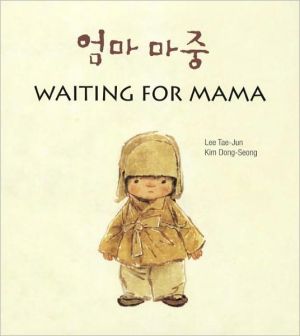Waiting for Mama
Told in a few lines of text, this tender story was first published in a newspaper in 1938. This tale from Korea is universal—a small child waits for Mama at the station, asking the conductor if he has seen her. The conductor hasn't, but cautions the child to wait a little farther from the tracks. It is cold and snowy but the child waits patiently until finally Mama comes. In the last wordless spread, we see the small hand in a mother's firm clasp as they walk away from us. The art and text...
Search in google:
Told in a few lines of text, this tender story was first published in a newspaper in 1938. This tale from Korea is universal—a small child waits for Mama at the station, asking the conductor if he has seen her. The conductor hasn't, but cautions the child to wait a little farther from the tracks. It is cold and snowy but the child waits patiently until finally Mama comes. In the last wordless spread, we see the small hand in a mother's firm clasp as they walk away from us. The art and text are so authentic, so real, that this book is best published in a bilingual edition that respects and honors those traditions. The Korean setting gives it special appeal to a growing demographic segment. The institutional market is especially hungry for bilingual books in languages beyond Spanish.Mary HazeltonCopyright 2006 Reed Business Information. - School Library JournalK-Gr 2Originally published in a Korean newspaper in 1938, this slight story tells of a very young boy waiting patiently for his mother at her streetcar stop. He asks one driver after another if she is coming, standing alone in the cold as daylight dims and snow begins to fall. The last wordless spread shows a snow-covered village with the tiny, almost imperceptible figures of a woman and child walking hand-in-hand through the storm. Readers need to look carefully at this spread to find the pair; otherwise the story is baffling and tragic. The Korean text, written in Hangeul, is accompanied by the English translation, although many pages are wordless. The lovely new pastel-and-ink illustrations depict life of the period. Some are simple ink drawings on ivory pages; others fill the pages with color and texture. The contrast is very pleasing. Changes in perspective effectively create movement and involvement. The text seems secondary to the setting and the art. An afterword on various details in the pictures is included. A worthwhile addition for its multicultural interest and its striking illustrations.
\ School Library JournalK-Gr 2\ Originally published in a Korean newspaper in 1938, this slight story tells of a very young boy waiting patiently for his mother at her streetcar stop. He asks one driver after another if she is coming, standing alone in the cold as daylight dims and snow begins to fall. The last wordless spread shows a snow-covered village with the tiny, almost imperceptible figures of a woman and child walking hand-in-hand through the storm. Readers need to look carefully at this spread to find the pair; otherwise the story is baffling and tragic. The Korean text, written in Hangeul, is accompanied by the English translation, although many pages are wordless. The lovely new pastel-and-ink illustrations depict life of the period. Some are simple ink drawings on ivory pages; others fill the pages with color and texture. The contrast is very pleasing. Changes in perspective effectively create movement and involvement. The text seems secondary to the setting and the art. An afterword on various details in the pictures is included. A worthwhile addition for its multicultural interest and its striking illustrations.\ —Mary HazeltonCopyright 2006 Reed Business Information.\ \ \ \ \ \ Kirkus ReviewsIn this quiet tribute to filial devotion, a little Korean boy climbs onto the high platform of a streetcar station to wait for his mother. As each streetcar arrives with passengers hurrying to and fro, he asks the driver if his mama is coming. Finally, one driver warns the boy he will get hurt if he stands so close to the streetcar and tells him to stand still until his mama comes. Time passes, the wind blows and snow falls as the obedient child waits patiently without moving or speaking until his mother arrives. Presented in Korean Hangeul as well as English, the spare text depends on the illustrations for context and mood. The muted watercolors capture people and scenery as they might have appeared in Seoul in 1938, when the story was first published. Bustling passengers, crowded streets and the anonymous streetcar are seen from the perspective of the small waiting boy. A perfect union of text and illustration tell a simple but moving story. (afterword) (Picture book. 3-6)\ \



![Tickle Monster Laughter Kit [With Tickle Mitts] Tickle Monster Laughter Kit [With Tickle Mitts]](/application/data/covers/98/35/9781932319835.jpg)




